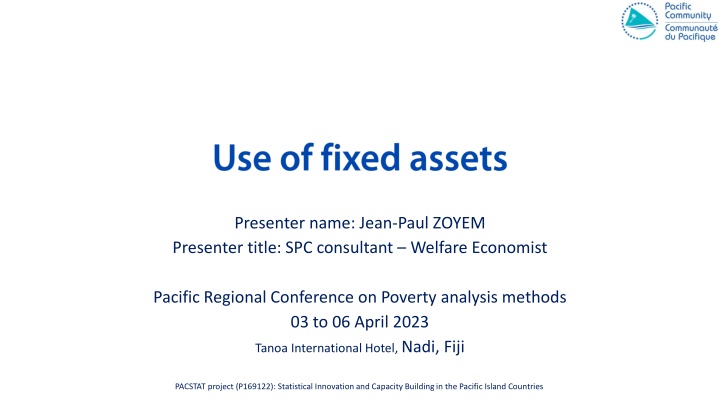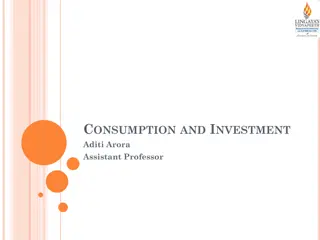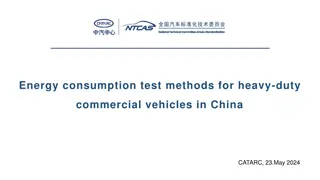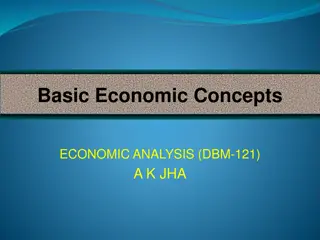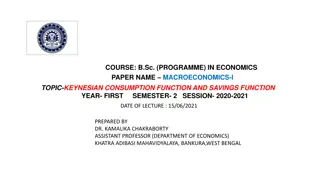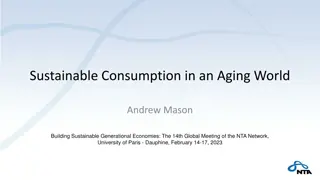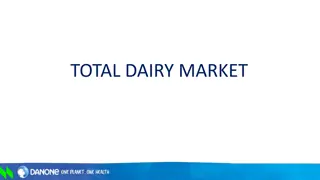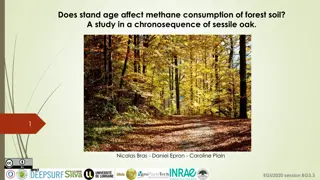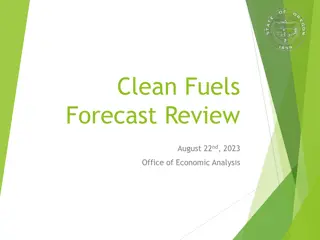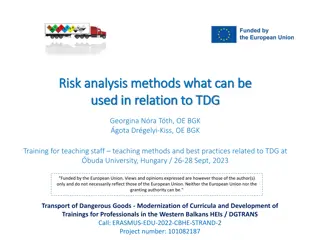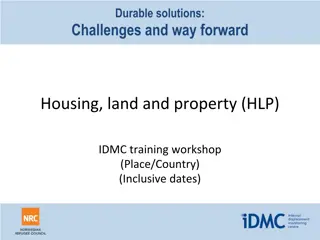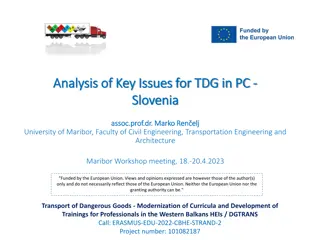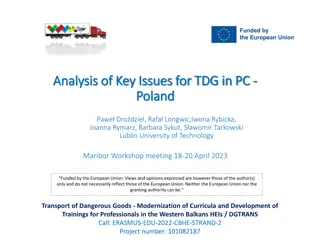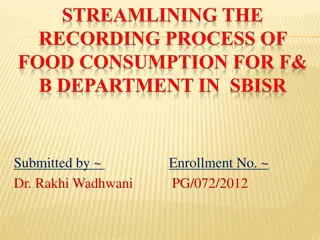Analysis of Durable Goods Consumption
Durable goods, such as appliances and electronics, play a significant role in consumption patterns. This analysis explores the distinction between durable and non-durable goods, methods to estimate consumption flow, and considerations in accounting for durable goods within consumption aggregates.
Download Presentation

Please find below an Image/Link to download the presentation.
The content on the website is provided AS IS for your information and personal use only. It may not be sold, licensed, or shared on other websites without obtaining consent from the author.If you encounter any issues during the download, it is possible that the publisher has removed the file from their server.
You are allowed to download the files provided on this website for personal or commercial use, subject to the condition that they are used lawfully. All files are the property of their respective owners.
The content on the website is provided AS IS for your information and personal use only. It may not be sold, licensed, or shared on other websites without obtaining consent from the author.
E N D
Presentation Transcript
Presenter name: Jean-Paul ZOYEM Presenter title: SPC consultant Welfare Economist Pacific Regional Conference on Poverty analysis methods 03 to 06 April 2023 Tanoa International Hotel, Nadi, Fiji PACSTAT project (P169122): Statistical Innovation and Capacity Building in the Pacific Island Countries
Identification of durable goods Identification of durable goods Typology of non-food goods by durability: durable, semi-durable and non-durable Durable good is distinguished from a nondurable good by its ability to deliver useful services to a consumer through repeated use over an extended period of time (ILO 2004) In practice, welfare analysts follow this definition, and add two additional criterion: Extended period of time is understood as more than one year, The purchase price should be relatively high (no specific limit) Example of durable goods Air conditioner Bicycle Car/jeep Computer/laptop Washing machine Mobile phone Motorcycle Water pump Refrigerator Rice cooker Telephone Fan Iron TV Radio
Durable goods : Use value versus Purchase value Durable goods : Use value versus Purchase value How to account for durable good in consumption aggregate? Purchase value of the durable good Consumption flow: the fraction of the purchase value of the good that is used during the reference period. For a non-durable good we can agree the purchase price as the measure of the consumption flow; What about the durable good? The price paid when a durable good is purchased reflects the value of the durable for its entire life: in fact, it is the discounted value of the flow of services that the consumer will benefit from in the future. To be relevant, the purchase price cannot be used to measure the consumption flow of the durable good.
Use of durable good Use of durable good Life of a washing machine Lifespan of asset Date of end of use Date of purchase Reference period
Estimating the consumption flow of durable goods Main approaches of estimating the consumption flow of durable goods The acquisition approach consists in allocating the entire charge to the period of purchase. The rental equivalence approach for which the main idea is to estimate the utility that derives from using a durable good during the survey period by collecting information on how much it would cost to rent it for a year. The user cost approach estimates the consumption flow as the cost that the household is willing to pay for using the durable good for one year.
Estimating the consumption flow of durable goods Acquisition approach Consumption flow = Purchase price for a household who bought the durable good (suppose washing machine) during the survey period; Is zero for another household who did not pay the durable during that period. But, who owns and is using the durable that was bought years before; Therefore, the 2 households are getting comparable well-being from the durable; But the consumption aggregate is including a high value of durable use for the first one and zero for the second one. In simple acquisition approach considers that: items that are owned but were purchased before the survey year do not contribute to the household s well-being, while items purchased during the survey year contribute to the household s well-being for their full value.
Estimating the consumption flow of durable goods Rental equivalence approach The idea of this approach is to estimate the utility that derives from using a durable good during the survey period by collecting information on how much it would cost to rent it for a year. Consumption flow = curent rental value of the durable good for a year This approach assums that consumers can rent an old washing machine; which is questionnable : For most of the durable goods rental market does not exist; and Surveys do rarely collect data on the rent of durable goods;
Estimating the consumption flow of durable goods User cost approach The user cost approach estimates the consumption flow (CF) as the cost that the household is willing to pay for using the durable good for one year. Based on some mathematical asumptions this cost is shown as the sum of two components (skip and use the stop of 2 friends) ?? = ????+ ????where : ??is price of the durable good at the begining of the year period ??is the real interest rate ??is the annual depreciation rate of the good (due to both physical deterioration and loss of market value) ????is the the opportunity cost of the durable good, which is the interest one could have earned if one had invested the money corresponding to the value of the good in a bank account. ????is the depreciation of the durable good, that is, the drop in the value of the good during the year. ??is usually obtained from sources external to the survey. It is recommended to calculate ??as an average over several years, and to use that real rate for all durable goods.
User cost approach Comparison between two friends with two bank accounts One of the friends uses all the money to buy a washing machine while the second one decides to place its money for interest at rate r . Bank account 2 (P) Bank account 1 (p) One year late the machine owner decides to sell it and to put money back to the bank acount. After a year of using the machine has depreciated by u %. Thus the selling value is P-Pu. Pay washing machine at P amount Place money at interest rate r The balance of the first bank account is BA1=P - Pu while that of the second one is BA2=P+Pr Sell WM one year latter at P-Pu Bank account P+Pr Therefore, the cost of using the washing machine for one year is the difference between the two account balances BA2 BA1= (P+Pr) (P-Pu)= Pr + Pu
User cost approach Parameters Parametersof the User of the User cost costapproach approach ? is usually obtained from sources external to the survey. The challenge is. How to estimate the depreciation rate? Main Main models modelsto to estimate estimatethe the depreciation depreciationcost cost The geometric depreciation model : Assums that the depreciation rate ( ) is constant over time. The economic life depreciation model : Assums that the depreciation rate ( ) is constant over time; But at the moment it reaches the end of its life, it still embodies some positive economic value, which can be thought of as a scrap value. For example, the remaining value of the durable at its end of life can be 5%
User cost approach (skip) Mod lisation of the depreciation pattern The mod lisation of the depreciation patern describes how durable goods lose value year after year. Thus, Depreciation pattern depends on the sequence of depreciation rates ?1,?2,?3,...??where v is the vintage of the durable good and ?? 1 Various ways to modeling the depreciation pattern ; among which: The geometric depreciation model : Assums that the depreciation rate ( ) is constant over time. The economic life depreciation model : Assums that the depreciation rate ( ) is constant over time; But at the moment it reaches the end of its life, it still embodies some positive economic value, which can be thought of as a scrap value. For example, the remaining value of the durable at its end of life can be 5%
User cost approach (skip) Geometric depreciation model 1 ? where: ??,? ?0,? The depreciation rate can be expressed in the formula is ? = 1 ??,? is the market value at survey period t when the durable good is v years old ?0,? is the market value at survey period t when the durable good is new In practice, questionnaires often fail to record the exact pieces of information that appear in the formula. As a practical approximation for v (the age of the durable), the analyst may use the years of ownership of the good (this assumes that no used goods are ever purchased) Rather than asking for ?0,?(the current market value of a new item), many questionnaires record the price originally paid for the good when it was purchased,
User cost approach (skip) Economic life depreciation model The economic life depreciation model assumes that the scrap value equals some (small) proportion of the good's original purchasing value:??,?= ?0,?, where T is the maximum duration of the economic life of the durable. If = 0.05, for instance, the analyst is assuming that when the good reaches the end of the period when it is able to be used for its original purpose, the value of the good still equals 5 percent of the purchasing price. 1 ? where: Based on this assumption the depreciation rate is ? = 1 ? This formula facilitates the estimation of the consumption flow tremendously, not only for its analytical simplicity, but also because it is less demanding in terms of data, and can work when the survey only provides very limited information on durable goods, such as a mere inventory of goods owned by the households, and an estimate of their current value. However, a drawback associated to this formula is that the estimate of depends on the parameter , which is arbitrarily chosen by the analyst (any number between 1 and 10 percent appears to be a reasonable choice).
Consumption flow in the PICTs The user cost approach The recent poverty assessments in the PICTs tend to adopt the user cost approach for the estimation of the consumption flow of durable goods. They estimate the use value of each individual durable as a product of an estimated current value of the durable by an estimated depreciation rate applicable to that type of durable. However, this omits the opportunity cost of the durable which is the second component of the consumption flow as formulated in the use cost approach When the depreciation rate cannot be calculated from a dedicate survey on assets survey, an approximate information may be collected from other sources including data from Revenue Authority and any other institution that deals with assets. The depreciation rate from comparable country may also be adapted ; that is the case of Tonga 2021 Poverty report which used the the depreciation calculated for Vanuatu.
Consumption flow in the PICTs Data collected in the PICTs To be able to calculate the use value of the durable goods the following information were collected by the questionnaire for a given asset: The ownership of the asset by household members, Number of the assets owned by household members, Age of the assets, The acquisition mean of the assets (purchase new, purchase secondhand, received new as gift, received secondhand as gift), The price of the purchased assets, The self-estimated cost if the asset was to sell today.
Durable goods in the questionnaire Durable goods in the questionnaire Data needed for the estimation of the use value of the durable good Year of acquisition Way of acquisition Price of acquisition Resell price Price of acquisition H1205. How much did your household pay(if purchased) or would have paid (if received as gift) for this asset Resell price H1206. How much could your household receive if you to sell this asset today?
Durable goods in the questionnaire Durable goods in the questionnaire Inequal details of questions among durable goods Section 12-assets Only the last acquisition is detailed Number of assets is collected Section "13b-vehicles all vehicles were detailed (if the hh own 2 cars, both car have all the details) section "5 - communication" only the main goods are detailed P517. Thinking about %hmName%'s MAIN laptop computer, how manyyears has %heShe% owned it? The number owned is not collected
Impact of Impact of housing housing rent rent and durable and durable goods goods on on consumption consumption aggregate aggregate Changing of consumption (per AE) decile with inclusion of durable goods Decile after inclusion of durable goods Decile with no rent, no durable dec01 dec02 dec03 dec04 dec05 dec06 dec07 dec08 dec09 dec10 Total dec01 dec02 dec03 dec04 dec05 dec06 dec07 dec08 dec09 dec10 14 1 0 1 0 1 1 0 0 1 4 0 0 0 0 2 0 0 0 0 1 2 0 0 0 0 1 1 1 0 0 0 0 0 0 0 1 189 179 168 178 191 214 195 223 274 319 174 8 0 0 0 0 0 0 0 0 20 149 21 21 124 27 0 0 0 0 0 0 0 23 124 38 0 0 0 0 0 0 21 128 45 0 0 0 0 0 29 137 29 0 0 0 0 19 146 27 0 0 0 22 173 38 0 0 12 224 14 0 305 Total 182 184 172 184 198 192 204 233 263 318 2130
Impact of Impact of housing housing rent rent and durable and durable goods goods on on consumption consumption aggregate aggregate Changing of consumption (per AE) decile with inclusion of housing rent Decile after inclusion of housing rent Decile with no rent, no durable dec01 dec02 dec03 dec04 dec05 dec06 dec07 dec08 dec09 dec10 Total dec01 dec02 dec03 dec04 dec05 dec06 dec07 dec08 dec09 dec10 26 113 28 2 0 5 0 2 6 1 1 2 7 0 0 1 2 8 0 0 0 1 0 8 0 0 0 0 2 3 6 0 0 0 0 0 1 0 6 189 179 168 178 191 214 195 223 274 319 160 16 42 90 39 0 0 0 0 0 0 0 0 41 93 33 0 0 0 0 0 0 0 36 97 41 1 0 0 0 0 0 50 119 39 0 0 0 0 0 42 115 31 0 0 0 0 35 0 0 0 38 148 31 0 0 37 206 16 0 303 Total 176 167 174 172 182 219 199 223 271 347 2130
Impact of Impact of housing housing rent rent and durable and durable goods goods on on consumption consumption aggregate aggregate Changing of consumption (per AE) decile with inclusion of housing rent and durable goods Decile after inclusion of housing rent and durable goods Decile with no rent, no durable dec01 dec02 dec03 dec04 dec05 dec06 dec07 dec08 dec09 dec10 Total dec01 dec02 dec03 dec04 dec05 dec06 dec07 dec08 dec09 dec10 30 2 0 9 0 2 0 1 2 1 0 1 0 0 0 0 2 2 0 0 0 0 2 4 9 0 0 0 0 0 1 0 7 189 179 168 178 191 214 195 223 274 319 156 18 41 83 49 108 34 0 0 0 0 0 0 0 0 38 85 48 10 28 81 56 0 0 0 0 0 0 0 14 43 94 51 2 0 0 0 0 0 13 44 5 0 0 0 0 10 35 0 0 0 0 100 43 1 0 0 45 127 51 0 0 44 179 24 0 295 Total 174 172 177 185 177 206 202 227 263 347 2130
Impact of acquisition value of durable Impact of acquisition value of durable goods goods on on consumption consumption aggregate aggregate Changing of consumption (per AE) decile with acquisition of use value of durable goods Decile with acquisition value Decile with no rent, no durable dec01 dec02 dec03 dec04 dec05 dec06 dec07 dec08 dec09 dec10 Total 39 62 41 26 7 0 0 0 0 0 12 30 49 45 30 14 0 0 0 0 3 3 7 1 6 1 4 4 1 3 2 0 1 2 1 4 0 0 2 3 3 6 6 189 179 168 178 191 214 195 223 274 319 dec01 dec02 dec03 dec04 dec05 dec06 dec07 dec08 dec09 dec10 129 45 21 32 33 37 54 16 2 0 0 8 0 0 0 0 0 0 0 16 31 46 45 34 9 1 0 12 15 29 38 46 30 1 0 14 21 25 38 50 46 0 10 14 21 40 50 81 16 11 15 61 87 66 21 58 237 Total 182 175 180 198 192 178 203 238 248 336 2130
Impact of acquisition value of durable Impact of acquisition value of durable goods goods on on consumption consumption aggregate aggregate Share of durable goods in total consumption by inclusion approach Asset at acquistion value coicop_div_plus Food And Non-Alcoholic Beverages Restaurants And Hotels Restaurants And Hotels Alcoholic Beverages, Tobacco And Narcotics Clothing And Footwear Housing, Water, Electricity, Gas And Other Fuels Acquistion value Use value 29,00 0,51 7,27 3,73 2,28 4,16 38,51 0,68 9,65 4,96 3,03 5,52 Furnishings, Household Equipment And Routine Household Maintenance Health Transport Communication Recreation And Culture Education Restaurants And Hotels Miscellaneous Goods And Services housing rent durable use 1,84 0,17 5,49 2,24 0,71 0,95 1,18 4,28 7,45 28,75 2,44 0,23 7,29 2,98 0,95 1,26 1,56 5,69 9,89 5,37 Total 100,00 100,00
Impact of acquisition value of durable Impact of acquisition value of durable goods goods on on consumption consumption aggregate aggregate Changing poverty status by inclusion approach of durable good Decile with acquisition value non poor poor Total Decile with no rent, no durable non poor 93,7 6,3 100,0 poor 20,4 79,6 100,0 Total 79,1 20,9 100,0
Impact of Impact of housing housing rent rent and durable and durable goods goods on on poverty poverty rate rate Changing poor status with inclusion of durable goods Changing poor status with inclusion of housing rent 100% 100% 2,83 1,74 94,89 20,32 20,89 97,17 80% 80% poor 79,11 60% 60% 98,26 93,37 poor 40% 79,68 non poor 40% non poor 20% 20% 5,11 0% 0% non poor (no rent, no durable) poor (no rent, no durable) Total (no rent, no durable) 6,63 non poor (no rent, no durable) poor (no rent, no durable) Total (no rent, no durable) Changing poor status with inclusion of housing rent & durable goods Poverty rate by inclusion of housing rent and durable good rent no / durable good no yes Poverty rate (%) 19.95 20.32 rent no / durable good rent yes / durable good no 20.89 rent yes / durable good yes 20.71 100% 2,73 20,71 80% 60% 92,86 poor 97,27 40% 79,29 non poor 20% 7,14 0% non poor (no rent, no durable) poor (no rent, no durable) Total (no rent, no durable)
Thank you Address/post: Pacific Community (SPC), 95 Promenade Roger Laroque, BP D5 98848 Noumea, New Caledonia Phone: +687 262000 | Fax: +687 263818 | Email: complaints@spc.int | Web: https://spc.int/accountability
